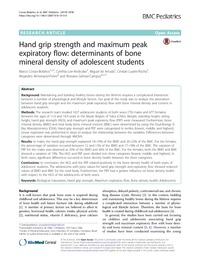Mostrar el registro sencillo de la publicación
Hand grip strength and maximum peak expiratory flow: determinants of bone mineral density of adolescent students
| dc.contributor.author | Cossio-Bolaños, Marco Antonio | |
| dc.contributor.author | Lee-Andruske, Cynthia | |
| dc.contributor.author | De Arruda, Miguel | |
| dc.contributor.author | Luarte Rocha, Cristian | |
| dc.contributor.author | Almonacid-Fierro, Alejandro | |
| dc.contributor.author | Gómez-Campos, Rossana | |
| dc.date.accessioned | 2018-05-18T20:51:36Z | |
| dc.date.available | 2018-05-18T20:51:36Z | |
| dc.date.issued | 2018 | |
| dc.identifier.uri | http://repositorio.ucm.cl/handle/ucm/1739 | |
| dc.description.abstract | Background: Maintaining and building healthy bones during the lifetime requires a complicated interaction between a number of physiological and lifestyle factors. Our goal of this study was to analyze the association between hand grip strength and the maximum peak expiratory flow with bone mineral density and content in adolescent students. Methods: The research team studied 1427 adolescent students of both sexes (750 males and 677 females) between the ages of 11.0 and 18.9 years in the Maule Region of Talca (Chile). Weight, standing height, sitting height, hand grip strength (HGS), and maximum peak expiratory flow (PEF) were measured. Furthermore, bone mineral density (BMD) and total body bone mineral content (BMC) were determined by using the Dual-Energy XRay Absorptiometry (DXA). Hand grip strength and PEF were categorized in tertiles (lowest, middle, and highest). Linear regression was performed in steps to analyze the relationship between the variables. Differences between categories were determined through ANOVA. Results: In males, the hand grip strength explained 18–19% of the BMD and 20–23% of the BMC. For the females, the percentage of variation occurred between 12 and 13% of the BMD and 17–18% of the BMC. The variation of PEF for the males was observed as 33% of the BMD and 36% of the BMC. For the females, both the BMD and BMC showed a variation of 19%. The HGS and PEF were divided into three categories (lowest, middle, and highest). In both cases, significant differences occurred in bone density health between the three categories. Conclusions: In conclusion, the HGS and the PEF related positively to the bone density health of both sexes of adolescent students. The adolescents with poor values for hand grip strength and expiratory flow showed reduced values of BMD and BMC for the total body. Furthermore, the PEF had a greater influence on bone density health with respect to the HGS of the adolescents of both sexes. | es_CL |
| dc.language.iso | en | es_CL |
| dc.rights | Atribución-NoComercial-SinDerivadas 3.0 Chile | * |
| dc.rights.uri | http://creativecommons.org/licenses/by-nc-nd/3.0/cl/ | * |
| dc.source | BMC Pediatrics, 18, 96 | es_CL |
| dc.subject | Biological maturation | es_CL |
| dc.subject | Hand strength | es_CL |
| dc.subject | Maximum expiratory flow | es_CL |
| dc.subject | Bone density health | es_CL |
| dc.subject | Adolescents | es_CL |
| dc.title | Hand grip strength and maximum peak expiratory flow: determinants of bone mineral density of adolescent students | es_CL |
| dc.type | Article | es_CL |
| dc.ucm.facultad | Facultad de Ciencias de la Educación | es_CL |
| dc.ucm.indexacion | Scopus | es_CL |
| dc.ucm.indexacion | Isi | es_CL |
| dc.ucm.doi | doi.org/10.1186/s12887-018-1015-0 | es_CL |



